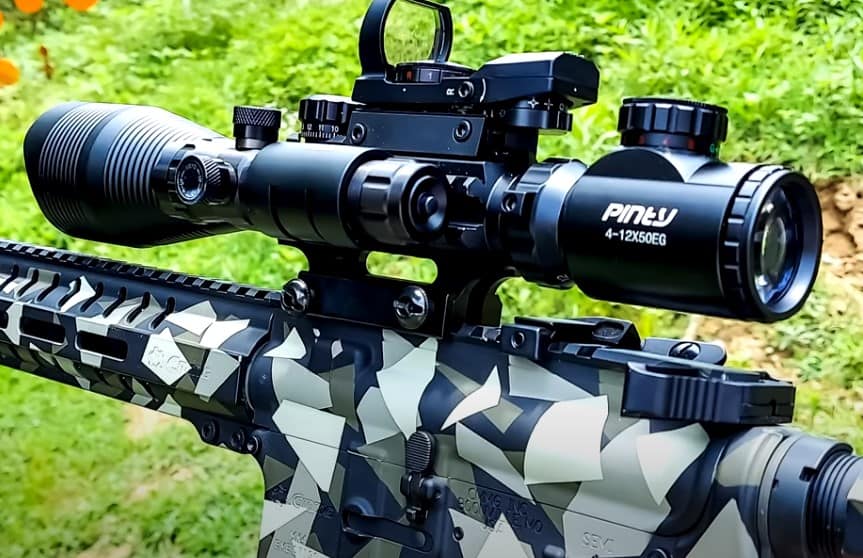4 Rules To Follow When Trying To Buy A Used Optic

Buying a used optic is often a good way to find the scope you want or need while saving a few bucks in the process.
Now, since optics are finicky things, it’s best to be cautious. Let’s face it an optic is like anything made with primarily glass components, fragile. And we all know that buying a used broken optic is not exactly saving money.
When it comes to buying used optics, it’s best to get your hands on the optic before you commit to any kind of purchase. Unfortunately, since so many purchases take place online, this is very difficult to do.
If you are looking at doing a strictly online option, you need to consider the seller’s reputation and understand their return policy.
If you are looking to buy a used scope in person, there is a number of different things you should do before buying said optic.
Rule #1. Look Through It
This is probably something you are going to do anyway, right? Well, there are a number of things to look for. Is the sight picture clear and bright? If so, you’re good to go.
If the picture appears dim, dull, or fuzzy, stay away from it. Is the reticle even and flush? Any kind of offset in the reticle is important to note, as it will affect shot placement.
If the scope has an illumination function, ensure it works properly. If you are looking through the optic inside, in air conditioning, take it outside. See if any kind of internal fog builds up on the lenses; this is a clear sign the fog proof feature is gone.
Rule #2. Check the Turrets
Turrets requiring tools to make adjustments are specifically susceptible to damage. Someone a little overzealous with a screwdriver can cause a lot of damage to the adjustment turrets.
Look for damage on sections where the tool is intended to be used; scratches and gouges are clear giveaways of neglect. Make a few adjustments, and ensure every click is tactile, up, and down.
Also, keep an eye on the O-rings that typically seal around the turrets; make sure they are not worn or missing. Fingertip adjustments are a bit easier, ensure they move with ease and the adjustments are tactile.
Rule #3. Look At The Whole Frame!
Scope torque can be a nasty business, a poorly mounted scope and base can slightly bend an optic. This can completely ruin an optic, so you need to be very careful when buying a scope.
Hold the scope outwards and make sure the scope is perfectly straight. The bend can be very subtle and hard to see, so pay close attention to it.
Also, not any damage to the finish or any scratches or gouges in the metal. Any small dents or dings can give away that this scope had a very hard life.
A dent or gouge doesn’t mean that the scope doesn’t work, but it is a clear indication that the scope may have an issue or two.
Rule #4. Who Makes The Scope?
This could be possibly the most important factor to consider. You can never be 100 percent sure that an optic will work as advertised without being put on a rifle and having its trigger pulled.
What you can do, however, is research the company that produced the optic. First off is knowing the quality of the manufacturer. For example, Trijicon makes optics that are nearly bulletproof; you can almost guarantee that an ACOG will still be working.
The other reason you should know this is due to warranty information. How long does the company warranty its work? Is the warranty transferrable between owners?
For example, Leupold offers a lifetime warranty, registration is not required, and the warranty transfers between owners. Important information to know.
When Buying Used Scopes, Consider The Following Factors
In order to get fully outfitted, you need a rifle scope. The following section will help you find the right scope for your gun, including what to look for and how to find a used scope.
Read on to learn how to maximize your used scope budget no matter how much you have to spend.
Make Sure You Really Need A Scope Before You Invest In One
A lot of cool hunting equipment has been developed thanks to technological advancements. You can buy almost anything that makes your hunting experience easier and more convenient.
You don’t necessarily need something just because it’s available. Hunting has been around for literally thousands of years. Compared to other hunting technologies, guns are relatively new.
Therefore, you might not even need or want a scope. You should think about what you will use a scope for before investing hundreds of dollars in one.
A scope increases aiming accuracy, particularly at long distances. You will definitely need a scope if you plan to shoot from hundreds of yards away. How come? It is never a good idea to wound an animal that will suffer needlessly.
Keeping The Equipment In Good Condition
Maintenance is another factor to consider. If your rifle scope gets dirty from rain, dust, mud, or any other type of debris in the field, make sure you can clean it easily.
Decide On A Budget
It’s a good idea to decide what your budget is before shopping around. It’s important to remember that even less expensive scopes aren’t cheap. Thousands of dollars can easily be spent on scopes that feature all the latest bells and whistles.
You might be able to bag that trophy buck you’ve been dreaming of for a small price, but don’t break the bank.
A ratio of 2 to 1 is one thing to consider. You should pay half as much for your scope as you did for your gun, according to this rule.
As an example, if you spent $1000 on your gun, you should spend $500 on your scope. Although it is not a hard and fast rule, it does provide a reasonable guideline.
Taking an in-depth look at your personal finances is just as important as making any other major purchase. Prioritize your hunting experience and your budget based on how important a more expensive scope is.
Choose The Right Scope For Your Project
Choosing the right scope for your needs is the next step. A tactical scope, for instance, has a low magnification to make it easier to find your target quickly.
It is also ideal for close-range targets due to low magnification, which allows for a wider field of view. When hunting in extreme conditions, precision scopes provide a wide range of magnification along with the ability to adjust for wind or elevation.
When stalking your target on foot, this ability to zoom in and out can make all the difference.
Having a hunting scope with adequate magnification is essential for capturing large as well as small games. In general, you should use less magnification when working.
Final Words
Cha-Ching! If you can get a good deal on a used optic, there is no reason not to take it as long as it passes the sniff test.
Buying used can be a great way to save tens or even hundreds of dollars and the optic of your dreams. Just follow a few rules we’ve laid out here and you should be able to pick a winner.

